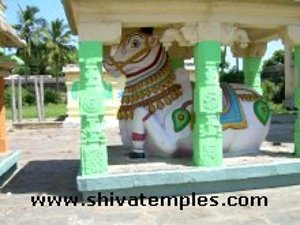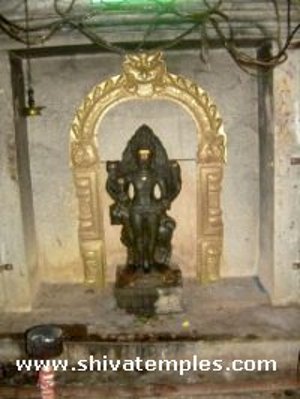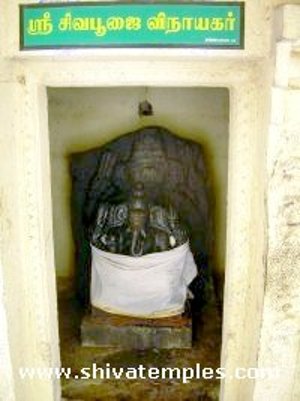Temple Legend - This Shiva temple at Aamathur is renowned for its tri-glories - sthalam (site), Murthi (idol), and Theertham (water body).
In the beginning, cows were without horns. To protect themselves from predators, Kamadhenu, the divine cow and the rest of the cattle approached Nandi to request the bestowal of horns. Acknowledging the validity of their request, Nandi advised them to go to a forest abundant with 'vanni' trees along the river Pampa and asked them to worship God Shiva. The cows stumbled upon a 'Swayambhoo Linga' in the forest. Praying to the Linga, they engaged in a rigorous penance for several days. As a result of their unwavering devotion, the cows were eventually granted the gift of horns. The name 'Aamathur' is derived from this act of worship by cows ('Aa'-cow). According to the Sthala Purana, anyone who discusses this temple or even listens to the magnificence of this 'sthalam' will receive divine blessings.
Sage Bhringi was devoted solely to the worship of God Shiva. Even when Shiva and Parvathy combined to create the composite deity Ardhanarishvara, the sage would take on the form of a female beetle (Bhringi) and would encircle only Shiva's half, ignoring Parvathy's half, through a pierced hole. Parvathy, feeling disrespected, cursed the sage, causing him to transform into a 'Vanni' tree at this location. As a result, the Vanni tree became the 'sthala vruksham' of this temple.
Temple Layout - There are two temples in Tiruamathur.
The first temple, presided over by the deity Aamatheeswarar, features a magnificent 7-tiered gopuram and is east facing surrounded by a well-built wall. A grand Nandi greets us as we enter through the gateway into the outer prakaram. This prakaram is home to 'worth-seeing' sannidhis dedicated to Siddhi Vinayaka, Shanmuka and Esanya Lingeswara. Achutharayar who played a significant role in renovating this temple, has a place in the north-east corner of the outer prakaram and his statue serves as a testament to his contribution.
A flight of stairs near the sannidhi of Siddhi Vinayaka lead to the inner prakaram. At the landing is the Nataraja Sabha, facing south. There are numerous sannidhis in this prakaram such as the 63 Nayanmars, Kalabhairava, Dakshinamurthy, Sanakathi Rishis, Saptha Mathas, Rama, Muruga and Goddess Lakshmi. There is a beautiful depiction of Vinayaka engaged in Shiva Puja. The sanctum is surrounded by a trench-like structure, and we can see colorful Dwarapalakas on either of the sanctum's entrance. The presiding deity Abhirameswarar is a 'Swayambhoo Linga' also known as Azhagiyanathar. The Linga bears the imprint of cow hoof, like the crescent moon, symbolizing the reverence offered by these sacred animals. This leaves a subtle leftward inclination on the Linga. Rama himself worshipped at this sacred place giving the name Abirameswarar to the presiding deity.
Sage Mathanga created the 'theertham' within the temple premises and it is believed that just sprinkling the water from this theertham can bestow 'punniya'.
The temple dedicated to Goddess Muthambikai has a 5-tiered gopuram that faces west. Upon entering the outer prakaram, visitors will notice the prominent dwajasthambam, balipeetam, and a lion instead of nandhi. Colorful 'Dvarapalakis' can be seen on either side of the inner gateway, leading to the beautiful west-facing sannidhi of Goddess Muthambikai, radiating grace to the devotees.
Situated in the southern part of the prakaram encircling the sanctum of Devi Muthambikai, is a circular rock called Vatta paarai, which is accompanied by a Linga. According to ancient tales, this rock holds immense significance as it was the very place where Ram and Sugriv entered into a solemn agreement, with Hanuman as their witness, before defeating Vali. In the local community, it is a tradition for individuals to settle their disputes by taking an oath on this sacred circular rock. Considered as a place of worship, it is believed that those who dare to deceive or lie in front of it will face irreversible suffering.
The historical significance of 'Vattaparai' sannidhi lies in a story of betrayal and justice-seeking involving two brothers. The younger brother, upon learning that his elder brother had dishonestly acquired his property, confronted him and requested its return. Despite the younger brother's demands, the elder brother adamantly refused to return the property. To seek justice, the younger brother sought resolution from the village council.
The council directed the older sibling to swear an oath at the shrine of 'vattaparai amman' as evidence of his assertion. The Crafty elder brother devised a plan to deceive by gathering the value of his younger brother's assets in gold and concealing it within the decorative knob of his walking cane. Carrying the cane, he presented himself before the council and his brother. He then handed over the cane to the younger brother and solemnly declared with both hands that he possessed none of his sibling's property.
Unaware of the elder brother's deceit, the assembled villagers and the council had no choice but to dismiss the younger brother's claims. The elder brother, triumphant in his deception, reclaimed the cane from his younger brother and embarked on a journey of approximately 9 kilometers to the Thumbur Nagamman temple. Upon reaching the temple, he proudly boasted about how the divine power of the Goddess had no effect on him.
According to historical accounts, it was at this precise moment that a venomous black snake emerged and fatally bit the elder brother. On the location, a statue of a snake now stands as a testament to the incident. Additionally, an impression of a serpent's tail can still be observed on the chest of Devi Muthambigai, serving as tangible evidence of the occurrence. Devotees seeking confirmation of this can seek the guidance of the Sivachariya.
There are 5 pathikams (by Tirugyanasambandar - 2, by Tirunavukkarasar - 2, by sundarar - 1 )sung in praise of the presiding deity Abhirameshwara. Irattai pulavargal (Twin brothers) too have sung a 'kalambakam' (a form of poetry) praising the presiding deity.
 7 tier Gopuram
7 tier Gopuram 5 tier Gopuram
5 tier Gopuram Nandi
Nandi Kalabhairavar
Kalabhairavar Vinayaka in shiva pooja
Vinayaka in shiva pooja Dakshinamurthy
Dakshinamurthy Inside view
Inside view Eeshanya Lingeshwara
Eeshanya Lingeshwara